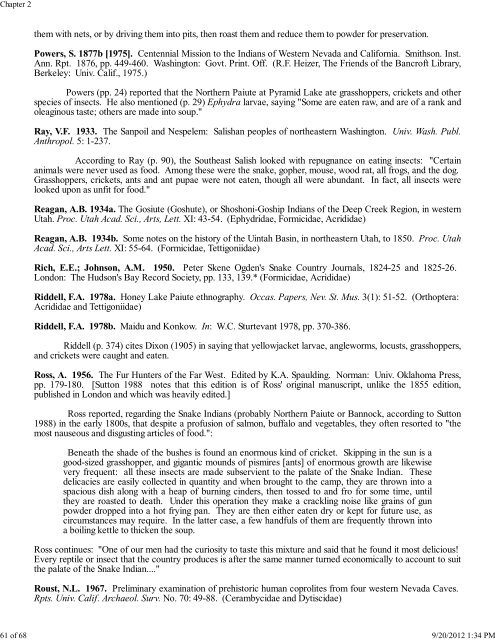Chapter 2. Insect Foods of North American Indigenous Populations ...
Chapter 2. Insect Foods of North American Indigenous Populations ...
Chapter 2. Insect Foods of North American Indigenous Populations ...
You also want an ePaper? Increase the reach of your titles
YUMPU automatically turns print PDFs into web optimized ePapers that Google loves.
<strong>Chapter</strong> 261 <strong>of</strong> 68 9/20/2012 1:34 PMthem with nets, or by driving them into pits, then roast them and reduce them to powder for preservation.Powers, S. 1877b [1975]. Centennial Mission to the Indians <strong>of</strong> Western Nevada and California. Smithson. Inst.Ann. Rpt. 1876, pp. 449-460. Washington: Govt. Print. Off. (R.F. Heizer, The Friends <strong>of</strong> the Bancr<strong>of</strong>t Library,Berkeley: Univ. Calif., 1975.)Powers (pp. 24) reported that the <strong>North</strong>ern Paiute at Pyramid Lake ate grasshoppers, crickets and otherspecies <strong>of</strong> insects. He also mentioned (p. 29) Ephydra larvae, saying "Some are eaten raw, and are <strong>of</strong> a rank andoleaginous taste; others are made into soup."Ray, V.F. 1933. The Sanpoil and Nespelem: Salishan peoples <strong>of</strong> northeastern Washington. Univ. Wash. Publ.Anthropol. 5: 1-237.According to Ray (p. 90), the Southeast Salish looked with repugnance on eating insects: "Certainanimals were never used as food. Among these were the snake, gopher, mouse, wood rat, all frogs, and the dog.Grasshoppers, crickets, ants and ant pupae were not eaten, though all were abundant. In fact, all insects werelooked upon as unfit for food."Reagan, A.B. 1934a. The Gosiute (Goshute), or Shoshoni-Goship Indians <strong>of</strong> the Deep Creek Region, in westernUtah. Proc. Utah Acad. Sci., Arts, Lett. XI: 43-54. (Ephydridae, Formicidae, Acrididae)Reagan, A.B. 1934b. Some notes on the history <strong>of</strong> the Uintah Basin, in northeastern Utah, to 1850. Proc. UtahAcad. Sci., Arts Lett. XI: 55-64. (Formicidae, Tettigoniidae)Rich, E.E.; Johnson, A.M. 1950. Peter Skene Ogden's Snake Country Journals, 1824-25 and 1825-26.London: The Hudson's Bay Record Society, pp. 133, 139.* (Formicidae, Acrididae)Riddell, F.A. 1978a. Honey Lake Paiute ethnography. Occas. Papers, Nev. St. Mus. 3(1): 51-5<strong>2.</strong> (Orthoptera:Acrididae and Tettigoniidae)Riddell, F.A. 1978b. Maidu and Konkow. In: W.C. Sturtevant 1978, pp. 370-386.Riddell (p. 374) cites Dixon (1905) in saying that yellowjacket larvae, angleworms, locusts, grasshoppers,and crickets were caught and eaten.Ross, A. 1956. The Fur Hunters <strong>of</strong> the Far West. Edited by K.A. Spaulding. Norman: Univ. Oklahoma Press,pp. 179-180. [Sutton 1988 notes that this edition is <strong>of</strong> Ross' original manuscript, unlike the 1855 edition,published in London and which was heavily edited.]Ross reported, regarding the Snake Indians (probably <strong>North</strong>ern Paiute or Bannock, according to Sutton1988) in the early 1800s, that despite a pr<strong>of</strong>usion <strong>of</strong> salmon, buffalo and vegetables, they <strong>of</strong>ten resorted to "themost nauseous and disgusting articles <strong>of</strong> food.":Beneath the shade <strong>of</strong> the bushes is found an enormous kind <strong>of</strong> cricket. Skipping in the sun is agood-sized grasshopper, and gigantic mounds <strong>of</strong> pismires [ants] <strong>of</strong> enormous growth are likewisevery frequent: all these insects are made subservient to the palate <strong>of</strong> the Snake Indian. Thesedelicacies are easily collected in quantity and when brought to the camp, they are thrown into aspacious dish along with a heap <strong>of</strong> burning cinders, then tossed to and fro for some time, untilthey are roasted to death. Under this operation they make a crackling noise like grains <strong>of</strong> gunpowder dropped into a hot frying pan. They are then either eaten dry or kept for future use, ascircumstances may require. In the latter case, a few handfuls <strong>of</strong> them are frequently thrown intoa boiling kettle to thicken the soup.Ross continues: "One <strong>of</strong> our men had the curiosity to taste this mixture and said that he found it most delicious!Every reptile or insect that the country produces is after the same manner turned economically to account to suitthe palate <strong>of</strong> the Snake Indian...."Roust, N.L. 1967. Preliminary examination <strong>of</strong> prehistoric human coprolites from four western Nevada Caves.Rpts. Univ. Calif. Archaeol. Surv. No. 70: 49-88. (Cerambycidae and Dytiscidae)
















